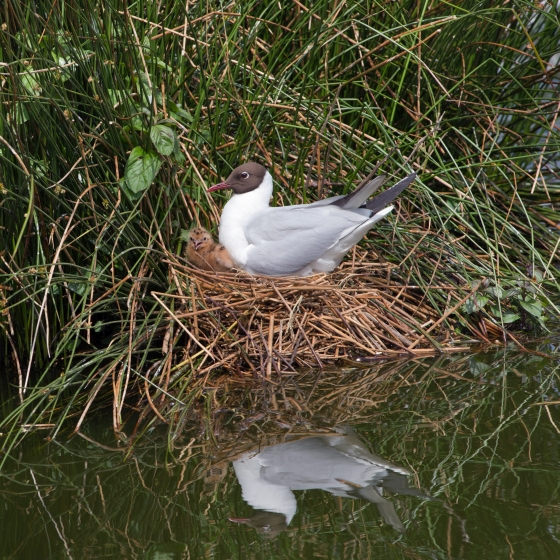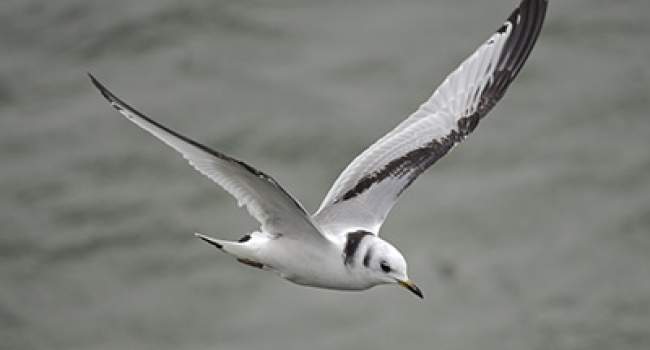Black-headed Gull
Chroicocephalus ridibundus (Linnaeus, 1766)
BH
 BLHGU
BLHGU  5820
5820

Family: Charadriiformes > Laridae

Perhaps the most familiar of our gull species, even though not the most numerous, the Black-headed Gull breeds and winters across most of Britain & Ireland, absent only from upland areas.
The Black-headed Gull is a colonial breeder, nesting at a wide range of coastal and inland waterbodies, both natural and artificial. Colony sizes can vary from just a few pairs to many thousands, and are usually obvious.
A contraction in the wintering range of this species within both Britain and Ireland is apparent in atlas data, with losses in central Wales, and across much of Ireland and parts of Scotland.
Identification
Black-headed Gull identification is often straightforward. The following article may help when identifying Black-headed Gull.
Identifying Kittiwake and other small gulls

Young Kittiwakes have a distinctive wing pattern, but several sought-after rarer species have similar markings - how can you tell them apart?
This video looks at several Gulls in juvenile plumage- Kittiwake, Little Gull, Black-headed Gull, Sabine's Gull and Ross's Gull.
- ‹ previous
- 2 of 2
SONGS AND CALLS
Listen to example recordings of the main vocalisations of Black-headed Gull, provided by xeno-canto contributors.
Call
Develop your bird ID skills with our training courses
Our interactive online courses are a great way to develop your bird identification skills, whether you're new to the hobby or a competent birder looking to hone your abilities.
Browse training coursesStatus and Trends
Population size and trends and patterns of distribution based on BTO surveys and atlases with data collected by BTO volunteers.
CONSERVATION STATUS
This species can be found on the following statutory and conservation listings and schedules.
POPULATION CHANGE
The UK population of Black-headed Gulls breeding at coastal colonies remained relatively stable between the 1969–70 Census and Seabird 2000 (1998–2002). However, the trend for inland breeding birds, which make up nearly half the population, is unknown as inland colonies were not surveyed fully prior to Seabird 2000. Annual data from the Seabird Monitoring Programme suggest that numbers have continued to be stable or may have increased slightly since Seabird 2000; results from the more comprehensive Seabirds Count (2015–2021) will confirm the recent trend when they are available (JNCC 2022).
| UK breeding population |
No population change in UK (1995–2022) 
|
DISTRIBUTION
In winter, Black-headed Gulls have a near-ubiquitous distribution in lowland Britain & Ireland. In Britain the only significant gaps are in the Scottish and Welsh uplands, and the largest gaps in Ireland are in the northwest, between Antrim and Connemara. They nest in a wide range of coastal and inland, natural and man-made wetlands. Highest densities in Britain are in Orkney, northern England, East Anglia, the Thames Estuary, and the Solent, and in Ireland are more fragmented around Lough Neagh, Strangford Lough, and at several large wetland complexes scattered throughout the west and northwest.
Occupied 10-km squares in UK
| No. occupied in breeding season | 1048 |
| % occupied in breeding season | 35 |
| No. occupied in winter | 2348 |
| % occupied in winter | 78 |
European Distribution Map
European Breeding Bird Atlas 2
Breeding Season Habitats
| Most frequent in |
Estuaries 
|
Relative frequency by habitat
Relative occurrence in different habitat types during the breeding season.

DISTRIBUTION CHANGE
The breeding distribution change map can be divided roughly diagonally, with the north and west characterised by range losses contrasting with a predominance of range gains in the southeast.
Change in occupied 10-km squares in the UK
| % change in range in breeding season (1968–72 to 2008–11) | -12.5% |
| % change in range in winter (1981–84 to 2007–11) | --5% |
SEASONALITY
Black-headed Gulls are common and widespread, recorded throughout the year.

Movement
Information about movement and migration based on online bird portals (e.g. BirdTrack), Ringing schemes and tracking studies.
An overview of year-round movements for the whole of Europe can be seen on the EuroBirdPortal viewer.
RINGING RECOVERIES
View a summary of recoveries in the Online Ringing Report.
Foreign locations of birds ringed or recovered in Britain & Ireland

Biology
Lifecycle and body size information about Black-headed Gull, including statistics on nesting, eggs and lifespan based on BTO ringing and nest recording data.
SURVIVAL & LONGEVITY
View number ringed each year in the Online Ringing Report
Maximum Age from Ringing 
|
32 years 3 months 26 days (set in 2018) 
|
Typical Lifespan 
|
11 years with breeding typically at 2 year |
Adult Survival 
|
0.9  
|
Juvenile Survival 
|
0.447 (to age 2) 
|
BIOMETRICS
Wing Length 
|
Adults | 305.3±11.8 | Range 287–323mm, N=9456 |
| Juveniles | 300.5±11.7 | Range 283-318mm, N=790 | |
| Males | 312.2±9 | Range 298–326mm, N=191 | |
| Females | 297.1±8.6 | Range 281–314mm, N=98 |
Body Weight 
|
Adults | 289±33.8 | Range 240–348g, N=9111 |
| Juveniles | 286±41.7 | Range 218–360g, N=800 | |
| Males | 288±39.1 | Range 245–345g, N=148 | |
| Females | 252±28.5 | Range 200–307g, N=59 |
Feather measurements and photos on featherbase 
CODES & CLASSIFICATION
Ring size 
|
E |
Field Codes 
|
2-letter: BH | 5-letter code: BLHGU | Euring: 5820 |
For information in another language (where available) click on a linked name
Research
Interpretation and scientific publications about Black-headed Gull from BTO scientists.
CAUSES AND SOLUTIONS
Causes of change
Black-headed Gull productivity has fluctuated and may have been affected by predation from American Mink Neovison vison (Craik 1997), although it is unclear whether this may have driven population trends.
Links to more studies from ConservationEvidence.com
- Mitigation of bird collisions with transmission lines through groundwire marking
- Provision of nest cages to reduce little ringed plover Charadrius dubius nest predation at Welney, Norfolk, England
- Re-profiling of islands in a gravel pit to improve nesting conditions for terns Sterna and small gulls Larus at Dungeness RSPB reserve, Kent, England
Read more studies about Black-headed Gull on Conservation Evidence >
Would you like to search for another species?













Share this page